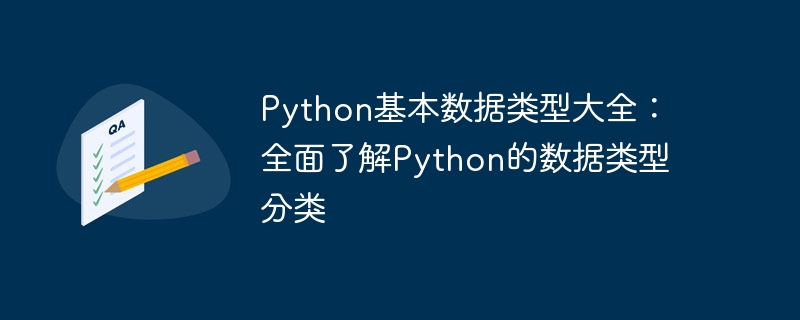Home >Backend Development >Python Tutorial >Detailed explanation of Python data types: Comprehensive understanding of the basic data types in Python
Detailed explanation of Python data types: Comprehensive understanding of the basic data types in Python
- 王林Original
- 2024-01-20 08:56:05921browse

Encyclopedia of Python basic data types: To fully understand Python’s data type classification, specific code examples are required
In the Python programming language, data types are a very important concept. Python provides a wealth of data types for storing and manipulating different types of data. In this article, we will introduce Python's basic data types and provide specific code examples to help readers better understand and use these data types.
- Number type
Number type is one of the most basic data types in Python. Python provides two number types: integer (int) and floating point number (float). Integers can represent integral values, while floating point numbers can represent numerical values with decimals.
The following are application examples of numeric types:
num1 = 10 # 整数类型 num2 = 3.14 # 浮点数类型 # 进行加法运算 result = num1 + num2 print(result) # 输出:13.14 # 进行乘法运算 result = num1 * num2 print(result) # 输出:31.400000000000002 # 进行除法运算 result = num1 / num2 print(result) # 输出:3.1847133757961785
- String type
String is the data type used to represent text in Python. A string consists of a series of characters, which can be represented by single quotes (') or double quotes (").
The following is an application example of the string type:
str1 = 'Hello, World!' # 使用单引号表示字符串 str2 = "Python Programming" # 使用双引号表示字符串 print(str1) # 输出:Hello, World! print(str2) # 输出:Python Programming # 字符串拼接 result = str1 + ' ' + str2 print(result) # 输出:Hello, World! Python Programming # 字符串长度 length = len(str1) print(length) # 输出:13 # 字符串切片 slice = str2[0:6] print(slice) # 输出:Python
- List type
A list is a data type used in Python to represent a set of ordered elements. The elements in the list can be different types of data, including numbers, strings, etc.
The following is an application example of the list type:
list1 = [1, 2, 3, 4, 5] # 整数类型列表
list2 = ['apple', 'banana', 'orange'] # 字符串类型列表
print(list1) # 输出:[1, 2, 3, 4, 5]
print(list2) # 输出:['apple', 'banana', 'orange']
# 列表长度
length = len(list1)
print(length) # 输出:5
# 列表元素访问
element = list2[1]
print(element) # 输出:banana
# 列表元素修改
list1[0] = 10
print(list1) # 输出:[10, 2, 3, 4, 5]
# 列表元素添加
list2.append('grape')
print(list2) # 输出:['apple', 'banana', 'orange', 'grape']- Tuple type
Tuple is a data type used to represent an immutable ordered collection of elements in Python. Unlike a list, the Elements cannot be modified.
The following is an application example of the tuple type:
tuple1 = (1, 2, 3, 4, 5) # 整数类型元组
tuple2 = ('apple', 'banana', 'orange') # 字符串类型元组
print(tuple1) # 输出:(1, 2, 3, 4, 5)
print(tuple2) # 输出:('apple', 'banana', 'orange')
# 元组长度
length = len(tuple1)
print(length) # 输出:5
# 元组元素访问
element = tuple2[1]
print(element) # 输出:banana- Dictionary type
A dictionary is used in Python to represent a collection of key-value pairs Data type. Elements in the dictionary are accessed using keys, which must be unique.
The following is an application example of the dictionary type:
dict1 = {'name': 'Alice', 'age': 25, 'city': 'New York'} # 字符串类型键的字典
dict2 = {1: 'apple', 2: 'banana', 3: 'orange'} # 整数类型键的字典
print(dict1) # 输出:{'name': 'Alice', 'age': 25, 'city': 'New York'}
print(dict2) # 输出:{1: 'apple', 2: 'banana', 3: 'orange'}
# 字典元素访问
value = dict1['name']
print(value) # 输出:Alice
# 字典元素修改
dict1['age'] = 30
print(dict1) # 输出:{'name': 'Alice', 'age': 30, 'city': 'New York'}
# 字典元素添加
dict1['gender'] = 'female'
print(dict1) # 输出:{'name': 'Alice', 'age': 30, 'city': 'New York', 'gender': 'female'}Through this article, we have introduced in detail Python's basic data types include numeric types, string types, list types, tuple types and dictionary types. In order to help readers better understand and use these data types, we also provide specific code examples. I hope this article will be helpful to everyone Python learning helps!
The above is the detailed content of Detailed explanation of Python data types: Comprehensive understanding of the basic data types in Python. For more information, please follow other related articles on the PHP Chinese website!

